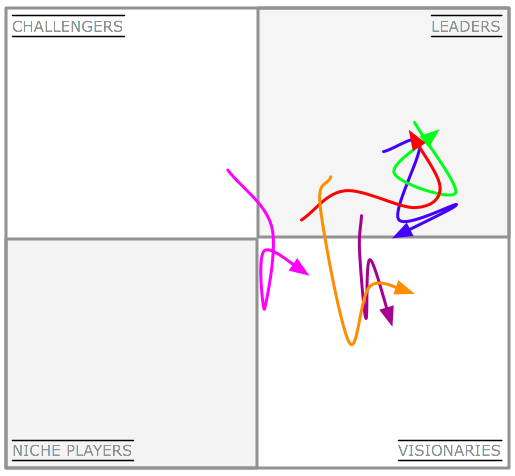Gamification of the Magic Quadrant
The figure below charts the development (in the eyes of Gartner) of six leading BPMS from 2009 through 2015.
Can you identify which line belongs to which vendor? If you can get more than four (without cheating and without using the clue at the bottom of this page) you’re officially a BPM expert and, if I don’t already know you, I’d love to catch up for a coffee sometime.

This is just intended as a bit of fun. I’m aware that this view of the data may be so fundamentally flawed (definitions change every year) that it’s useless but I have a curious mind (and I spend two hours a day on a bus).
Green’s obviously a good one, dancing around in the winners corner. Red looks like the one to watch, maybe I should get into Red. The rest of them all seem to be heading down (towards Visionary).
My interpretation of this trend is that the vendors are doing stuff (a bunch of which is probably good) but they aren’t making it succeed and, critically, they aren’t bringing their customers along with them on their vision.
This brings me to my point. BPM should be a verb and not a noun. The S in BPMS is the least important letter. If a company tells you that they have BPM (rather than they do BPM) then you have found your first problem to solve.
I generally claim the job title of BPM Consultant and I haven’t really touched a BPMS in the six months since starting my current role. Despite that fact, I entirely consider the work I’m doing to be BPM and I consider what’s been achieved so far to have been a real success, with regular tangible benefits having been delivered. We will get to the S when it distills its way up our backlog.
I think that’s enough text to keep the clue off the page. The BPMS are Appian, IBM, Oracle, Pega, Software AG and Tibco.
